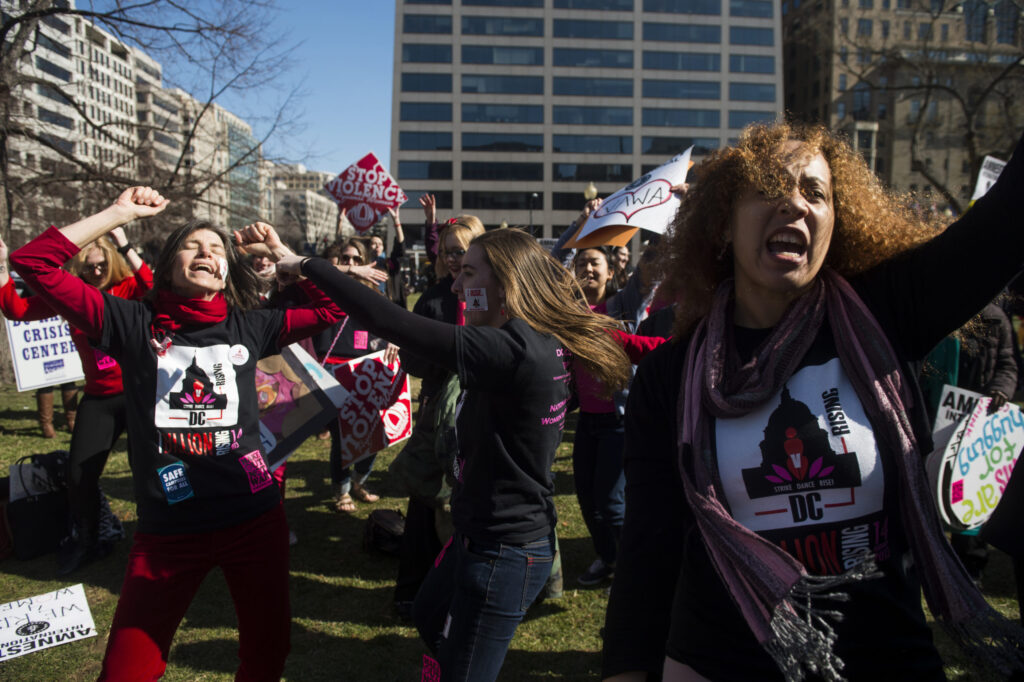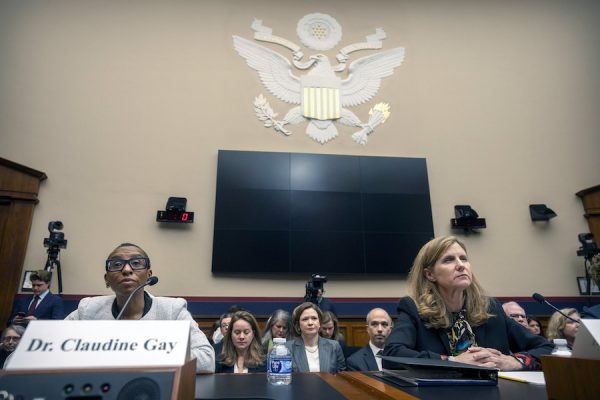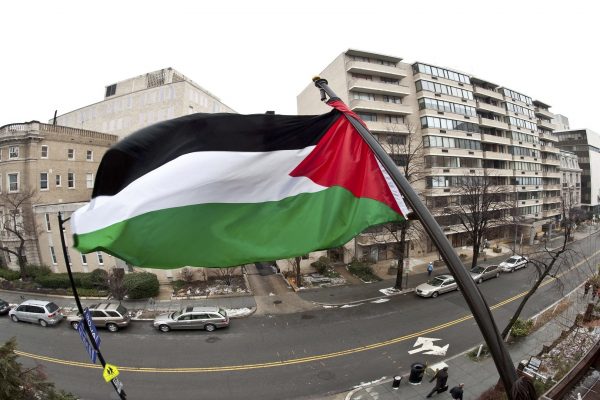The massive Black Lives Matter uprisings, alongside exposure of the squalid, often overcrowded, conditions that are allowing COVID-19 to burn through prisons and jails, have occasioned a broad rethinking of policing and incarceration. Calls to release prisoners and defund the police have, remarkably, gained official attention and triggered government action.
But even among proponents of shuttering prisons and defunding the police, one issue makes people anxious: sexual assault.
What about rape?
This is also a perennial question for feminists. Last year #MeToo drew attention to the pervasiveness of sexual harm while also letting the public in on debates within feminism/s about the solutions. Such debates are grounded in a long history. One form of feminism—what critics call “carceral feminism”—has played a role in the buildup of a what has been called the “sex offense legal regime”: the sprawling body of lengthy sentences, post-incarceration restrictions, and surveillance of people convicted of sex-related offenses. This regime must be abolished, not just because it is cruel and unjust, but also because it is ineffective in preventing or diminishing sexual violence.
Like us, other feminists, largely from communities of color, condemn the state’s punitive approaches to interpersonal harm and promote different ways to address sexual violence. Chief among these are restorative and transformative justice—nonviolent, community-based practices that facilitate real accountability for harm and center the needs of survivors. But sexual harm cannot be vanquished in isolation. It is necessary to transform systems and cultures to put community wellbeing before punishment and profit, and provide tools for dismantling the institutions, including policing, that perpetrate violence in response to violence.
In January 1971, the New York Radical Feminists, a small group of white left-wing women, convened a “rape speak-out” at a church on Manhattan’s Washington Square. Before a packed audience of 300, forty witnesses gave testimony. It may have been the first time American women gathered publicly to expose sexual violence, without self-blame, shame, or apology.
One speaker recalled the grade school ritual of “depantsing,” where boys chased girls to an empty lot, pulled down their underpants, spread their legs, and looked. Another woman had been raped by a gynecologist; a third instructed by her psychiatrist to masturbate in front of him. Women told of rape by husbands and brothers, friends, comrades, and strangers. New York Radical Feminists had decided to convene the speakout when women started telling their painful stories in consciousness-raising groups. Now, in the sanctuary, women were publicly “speaking bitterness,” as the Maoists used to call their collective ritual of class grievance. The writer Alix Kates Schulman later told Judith: “We were expressing outrage, the outness of rage.”
Women had a lot to be bitter and enraged about. Police routinely ignored, ridiculed, or sometimes brutalized rape victims. Hospitals triaged them to the bottom of the queue, to be treated after the “real” emergencies. To be believed, a woman had to show the bruises of physical coercion and resistance, even though the rapist may have wielded a weapon or threatened to mutilate or kill her if she refused him. The prosecutor had to produce eyewitness testimony to a crime almost always committed out of sight. The defense attorney could bring up the victim’s sexual history at trial to insinuate that she asked for it. In other words, a rape victim had to prove her own innocence before the rapist could be found guilty. Entire categories of sexual assault were invisible. No statute recognized marital rape; sex on demand was a husband’s prerogative and a wife’s duty. No one talked about child sexual abuse. There were few indictments, much less convictions, for sexual violence.
The organizers discouraged political rhetoric at the speak-out. But a few days later, they supplied their analysis in a one-page leaflet headlined “Manifesto of Shared Rape.” Rape—along with marriage and motherhood, control of women’s labor and property, and domestic violence—was an instrument of patriarchal oppression, “final proof of [men’s] power and [women’s] debasement as a possession, a thing, a chunk of meat,” the leaflet declared. “The act of rape is the logical expression of the essential relationship now existing between men and women. It is a matter to be dealt with in feminist terms for female liberation.” Rape was not a matter of individual pathology but a central truss in the edifice of patriarchy, affecting all women, even if they were never assaulted. Rape was political, said these women, so the response to rape had also to be political.
Feminists organizing around sexual and domestic violence in the early 1970s demanded changes in police, hospital, and courtroom procedures, but few had much confidence in a state that had turned its back on women and children for so long. Within a few years, a network of feminist rape crisis centers and a parallel network of “battered women’s” shelters sprang up across the country. Volunteers accompanied survivors to the emergency room or police station and through the courts, without pushing anyone to accept. The women or their male friends provided security, not the police. Consciousness-raising sessions were held in the cozy, toy-strewn spaces. The goal was nothing less than transformative—in the words of the 1972 mission statement of the flagship DC Rape Crisis Center, “to abolish rape in our own lifetimes.” Throughout the sixties these women had seen Republicans—presidential candidate Barry Goldwater, California Governor Ronald Reagan, President Richard Nixon—promote “law and order,” code for police crackdowns on communities of color, students, and protesters enraged by the murders of Black leaders and the slaughter in Vietnam.
If white feminists’ objections to this agenda came mostly from a political worldview, many women of color drew on personal experience. “Why bother going to the police?” asked Essie Green Williams, an anti-rape organizer with the National Black Feminist Organization, in an early 1970s interview. “The attitude of the police is that it’s just another Black person who has been hitting on another Black person. You know, ‘Ho-hum, they’re at it again.’ So Black women don’t report rape.”
But legal reform was not entirely off the table. Liberal feminists like the National Organization for Women, dissatisfied with but not disaffected from the system, lobbied to repeal sexist laws, wrote model legislation, and met with police and members of the judiciary to educate them about women’s frustrating and traumatizing experiences with the criminal legal system. Eventually, all these people, working both inside and outside the halls of power, won what are now considered basic survivor-supportive tenets of sex crimes law and courtroom procedure, such as the inadmissibility of an accuser’s sexual history, the criminalization of spousal rape, gender-neutral definitions of sexual assault that include nonpenetrative and nonconsensual acts perpetrated on any sex by any other sex, and a system of court-mandated services for victims. By the 1980s, police precincts and district attorneys had special units to respond exclusively to sexual violence.
But anti-violence feminists from the left, especially women of color, were adamantly opposed to outsourcing vengeance to the state. “It must be made clear that rape is not a law-and-order issue,” wrote New York Radical Feminists in 1974. “Women are not demanding castration nor are women demanding capital punishment. We do not want to make rape laws more punitive.”
By the 1980s, this militant, DIY anti-state spirit was moderating among the most visible, largely white anti-violence feminists. The United States had begun to “govern through crime,” as legal scholar Jonathan Simon puts it—that is, to address every social problem, essentially, by criminalizing it. Eventually these women joined forces with tough-on-crime politicians and right-wing Christians determined to protect their conceptions of female chastity and childhood innocence. Examining this alliance, in 2007 sociologist Elizabeth Bernstein coined the term “carceral feminism” to denote “the commitment of . . . feminist activists to a law and order agenda and . . . a drift from the welfare state to the carceral state as the enforcement apparatus for feminist goals.”
The landmark achievement of the carceral anti-violence and victims’ rights movements was the Violence Against Women Act of 1994. Finally, its proponents believed, the government would hold the perpetrators of intimate violence accountable. “The antiviolence movement believed that if we made these problems illegal they would go away,” said Leigh Goodmark, a lawyer for women who have suffered interpersonal violence, in a speech at the International Restorative Justice Conference in 2018. But they didn’t. The effect of arrest on recidivism, Goodmark noted, is “little to none.” This is because poor women and women of color are often reluctant to call the police, fearing that they will lose custody of their children, face deportation, come up against reports of substance abuse, or be accused of lying—to name only a few reasons. In fact, an analysis of FBI data found that “mandatory arrest laws actually increased intimate partner homicides.” The reason, the author hypothesized, was failure to report.
During its first twenty-plus years, VAWA may have helped a small segment of certifiably “good” victims—that is, white, female, cisgender, middle-class, and educated ones. But it did not cleanse the system of its inequities, and arguably, it has worsened them. The criminal legal system views women of color, poor women, single mothers, sex workers, lesbians, transwomen, migrants, people in prison, and other Others with suspicion. Any of these women must prove legitimacy as a victim—a quixotic effort.
And VAWA has not only failed to help; it has hurt many people of color. In jurisdictions with mandatory arrests for domestic violence, arrest rates of women of color are higher than in those without. A disproportionate number of women in prison are Black and brown; they are also, overwhelmingly, survivors of sexual and domestic abuse. But tougher policing and punishment of interpersonal violence have only swelled their numbers. As Beth E. Richie documents in Arrested Justice: Black Women, Violence, and America’s Prison Nation, laws like VAWA have increased prosecutions of women who fight back against abusers.
Perhaps VAWA’s pernicious effects should have been anticipated. After all, it was part of Bill Clinton’s bipartisan Violent Crime Control and Law Enforcement Act, which also created sixty new death penalty offenses, eliminated federal funds for in-prison college programs, poured billions into prison construction and police expansion, and required states to establish sex offender registries. At the same time Congress passed the crime bill, Clinton was also dismantling “welfare as we know it,” as he put it. While the crime bill expanded and deepened the prison nation, VAWA married anti-violence feminists to the violent state.
While it was primarily feminists of color who had sounded the alarm about these state-perpetrated harms in the early 1990s, when VAWA came up for reauthorization in 2013, some of the white feminists who fought for it in those years also began to waver in their zeal. Goodmark was one. Another is Karen Tronsgard-Scott, executive director of the Vermont Network Against Domestic and Sexual Violence, and a white lesbian from a working-class family, who came to the work in 1995, the year after the law’s enactment. “The law was all about building our relationship to the criminal legal system so it could do a good job. That had really good and really terrible consequences,” she explained. The main terrible one: “A whole raft of survivors were left out, because the way that the funding drove the services was toward this relationship. In order to access the services, you had to have the prosecution.”
The structure of VAWA, Tronsgard-Scott says, is upside-down: “Two-thirds of survivors want to have nothing to do with the criminal legal system, for lots of good reasons. But VAWA directs two-thirds of the funding to the criminal legal system and only one-third to victims services . . . That simultaneously forces the service sector into a container that moves further and further from a grassroots, community-based response and keeps them in a state of continuous scarcity.” This scarcity of resources, she adds, also creates a poverty of vision and impedes work for social, economic, and racial justice. “There’s just enough money to make things work, but not enough money to step back and ask: What are the root causes of violence, how are they related across oppressions, and how are we—the white women’s movement—complicit in perpetuating those causes?”
Even among white feminists who cut their political teeth in the Black-led civil rights movement, anti-violence organizing in the 1970s and ’80s remained largely racially segregated. Feminism spread organically through social circles, which rarely overlapped racial lines. Anti-violence workers were consumed with the daily crises of the women who came through the shelter doors; they did not stop to think about the racial makeup of their organizations. There were ideological reasons for this distance as well. Many white feminists hewed to the orthodoxy that women constituted a universal class, whose fundamental oppression supersedes differences of race, class, or sexuality. Rape is so profound and intimate a part of gender oppression, they reasoned, that organizing against it should unite all women. It did not.
In 1977, the Black and brown feminist lesbians of the Combahee River Collective published a statement that reflected the misgivings and visions of many women of color in the sometimes-dissonant struggles toward gender equality, sexual liberation, and racial justice.
We have a great deal of criticism and loathing for what men have been socialized to be in this society: what they support, how they act, and how they oppress. But we do not have the misguided notion that it is their maleness, per se—i.e., their biological maleness—that makes them what they are. As Black women we find any type of biological determinism a particularly dangerous and reactionary basis upon which to build a politic.
The collective rejected any analysis founded exclusively in the “sexual sources of women’s oppression,” because it “negates the facts of class and race.” Lesbian separatism, a small but politically influential tendency in the white women’s movement, was neither practical nor preferable, the collective wrote: “We struggle together with Black men against racism while we also struggle with Black men about sexism.”
Twelve years on, critical race theorist Kimberlé Crenshaw would popularize a term for what the collective was talking about. “Intersectionality” names the multiple identities and cultural, political, and economic conditions that make up a person and her situation. Intersectionality has profound ramifications for movement building, Crenshaw wrote:
If any real efforts are to be made to free Black people of the constraints and conditions that characterize racial subordination, then theories and strategies purporting to reflect the Black community’s needs must include an analysis of sexism and patriarchy. Similarly, feminism must include an analysis of race if it hopes to express the aspirations of nonwhite women. Neither Black liberationist politics nor feminist theory can ignore the intersectional experiences of those whom the movements claim as their respective constituents.
At that time, there were a handful of forums where activists of color and their white counterparts in the anti-violence movement were confronting the white supremacy that damaged solidarity and efficacy. In a 1990 interview, Loretta Ross recalled fruitful conflicts over race at the DC center. At first, the clientele did not reflect the African American majority demographic of the city—because the center’s staff did not. But the few workers of color enlightened their white colleagues about this, and the colleagues listened. The center amended its charter to mandate that the staff demographics match those of the client base. The center also recognized that the whiteness of its leadership would remain undiluted unless the center reached beyond the ranks of the feminist anti-violence movement as it was then constituted. In 1976 the center hired Nkenge Touré, the defense captain of the Black Panther Party, to be its director; Ross, a housing activist, succeeded her. Both became “lifelong feminists,” said Ross, “but without that special effort, it wouldn’t have happened.”
By the 2000s, women of color had begun to articulate another feature of the organizing landscape that was getting in the way of achieving true social transformation: on one hand, feminists addressing interpersonal violence were ignoring the violence of the state; on the other, anti-carceral movements were ignoring interpersonal violence. Women of color, disproportionately harmed by both, were left out in the cold.
In 2001, Andrea Ritchie, Alicia Beira, Mimi Kim, Andrea Smith, and others came together to form a national organization to address this mutual exclusion and work toward intersectional responses to sexual violence. The result was INCITE! Women of Color Against Violence (now called INCITE! Women, Gender Non-Conforming, and Trans People of Color Against Violence), which the same year joined the national grassroots abolitionist group Critical Resistance in releasing a “Statement on Gender Violence and the Prison Industrial Complex.” Like the Combahee River Collective, these writers acknowledged the emotions of other feminists who had faced the same problems but turned to strategies with which they fervently disagreed. The INCITE!/Critical Resistance statement read:
As abolitionists, we are confronted with the struggle between two conflicting forces for change . . . We share the feelings of outrage experienced by rape victims; we believe that repetitive rapists must be restrained from committing further acts of violence. On the other hand, we do not support the response of imprisonment. We challenge the basic assumptions that punishment, harsh sentences and retributive attitudes will serve to lessen victims’ pain, reeducate rapists or genuinely protect society.
The statement called for “responses to gender violence that do not depend on a sexist, racist, classist, and homophobic criminal justice system.” “To live violence-free lives,” it said, “we must develop holistic strategies for addressing violence that speak to the intersection of all forms of oppression.”
A dozen years later, Angela Davis gave this political construction the name “abolition feminism.” In a 2013 lecture at the University of Chicago, she began by speaking the names of Black women (including transwomen) victims of state violence and honoring the thinkers and organizers who came before her. Then she articulated this next phase of intersectional politics. “The people on the front lines against violence against women should also be on the front line of [prison] abolitionist struggles,” Davis proclaimed. And those “opposed to police crimes should be opposed to domestic — privatized —violence.”
Editor’s Note: This excerpt was adapted from The Feminist and The Sex Offender: Confronting Sexual Harm, Ending State Violence by Judith Levine and Erica R. Meiners. Copyright (c) 2020 Verso. Used by permission of Verso.









